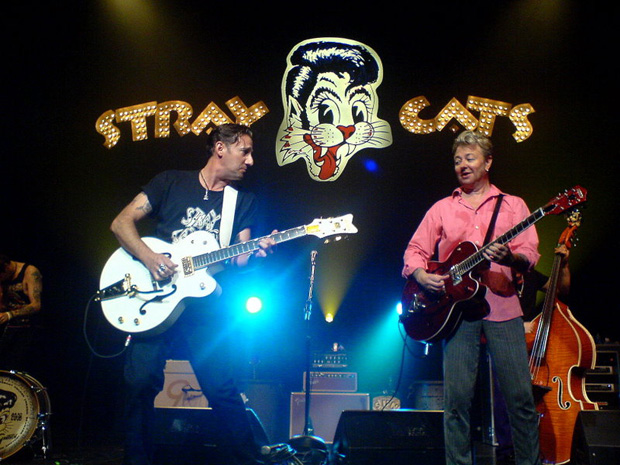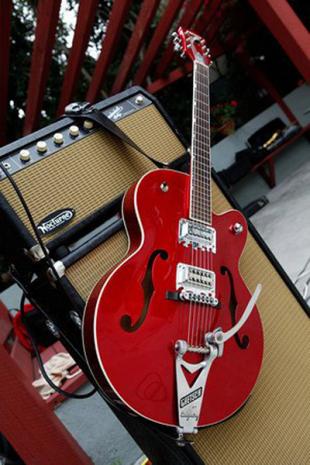Secrets of Great Tone: Gretsch, TV Jones, Fender and the Atomic Brain

No matter how long you’ve been playing guitar, one thing never changes: the desire to acquire the perfect tone.
It's a constant, never-ending quest. There’s always a new pedal, amp, pickup, speaker, tube, set of strings, pick or some other new development that promises to deliver the sound of angels singing as we strike our guitar strings.
One thing I have found that is certain (and less experienced players might find this a bit disheartening): Good tone comes more from a player’s fingers than anywhere else. More experienced players can make any gear sound pretty good, and less experienced players will buy everything under the sun in an attempt to achieve greatness, and still make even the most intoxicated audiences wince at the mere strumming of a simple E chord.
All this being said, gear still matters. After many years of ruining my own ears and the ears of others, I feel I have found a consistent tone that is usually in the ball park.
There are many different types of great tones, but I would like to focus the one I know and love, the one that seems to evade most novice Gretsch guitar player/owners. The tone I've been after, it's no surprise, was greatly influenced by Brian Setzer and his Gretsch 6120 guitar heard on all those early Stray Cats records.
From the moment I heard the sweet bell-like tones with just the right touch of growl, I knew how I wanted to sound. No other guitar looks or sounds anything like a Gretsch, and for me, there is no substitute.
Three major ingredients shape my tone: the pickups, the amp and my preamp pedal.
Get The Pick Newsletter
All the latest guitar news, interviews, lessons, reviews, deals and more, direct to your inbox!

Firstly, if you're a Gretsch fan, you've heard of TV Jones. TV began to dissect and perfect the sound of the early FilterTron pickups since the late ‘80s. He, along with Rich Modica, Brian Setzer's guitar tech for many years, resurrected the sound of vintage Gretsch guitars.
All versions of TV Jones pickups are stellar, but most prefer the classic FilterTrons. These pickups are that “vintage growl meets sweet tone” that is the driving force of all the great Stray Cats neo-rockabilly. (Indecently, I prefer the PowerTrons, which are wound heavier and have even more growl and midrange, but both types of pickups are fantastic.)
Secondly, you'll need a Fender amp. The ‘59 tweed Bassman and ‘63 blonde Bassman were Setzer's choice, but most tube Fenders will get you pretty close. Depending on the size of places you are playing, choose an amp with the right wattage so you may be able to turn it up to the "sweet spot" and get the natural breakup and sustain you desire. (I use a custom amp by Tavo Vega called a "Blondeshell" which is heavily influenced by the Fender ‘59 Bassman with many added features and upgrades.)
However, an easy amp to find is a ‘65 reissue Twin Reverb or Deluxe Reverb, depending on how loud you need to be. I'll stand by saying the ‘65 reissue Deluxe Reverb is one of the best reissue amps Fender has ever released and always a great choice.
For all of you guys in an uproar over this statement, I'm going to try and stop your attacks by saying there are many great vintage silver and blackface amps by Fender that sound amazing, but these reissues are great and much more accessible to all.
Many pickers will say the only thing you need between a Fender amp and Gretsch guitar to get good tone is a cord. Up until about a year ago, I would have agreed, but there is one pedal I cannot live without. This is the Atomic Brain.
Tavo Vega, I'm very proud to say, is my friend and probably the most passionate guy I know when it comes to great Gretsch tone. I have learned more from him on the subject in one year than I have in all of my past tone quests of the last two decades.
Tavo created the Atomic Brain, which recreates the preamp of an RE301 Space Echo.The Atomic Brain not only adds an organic growl without losing the clean, bell-like tone, but a bit of sparkle and sustain as well. You can turn up the preamp level to add as much or as little natural breakup as needed.
He has also included a second switch to give the pedal a 30 percent volume increase without changing the tone. This pedal has replaced all my other compressors, overdrives and volume boost pedals. The Atomic Brain and an analog delay (which type to use is a whole other blog post), is all I ever need to get the sound I've been looking for. It’s pure Gretsch tone -- nothing sweeter to a roots rocker's and rockabilly lover's ears.
Here are some links to the gear I mentioned. If you email or speak to someone there about gear after reading this, please mention that I sent you, as I am super-appreciative of all these great products and love when I hear that others have been driven to them through my music or endorsements.
Good Luck with the search.
Check out ...
and Fender.
And here's a video about the Atomic Brain:
Buzz Campbell, who is based in San Diego, plays guitar in the Lee Rocker Band and in Buzz Campbell & Hot Rod Lincoln. Check out the new Buzz Campbell solo album, Shivers & Shakes.
“The musicians, shops, and brands who use Reverb have always been at the center of all that we do”: Reverb has been acquired by two new investors – and will once again become an independently operated company
One of the UK's biggest guitar stores has sold its stock and website to online retailer Gear4music for $3.2 million – after weeks of speculation over its future









